

AWS Demo 1: Creating a VPC, Subnets, and Base Security Groups. Introduction to Amazon DynamoDB. Connect To Amazon EC2 Using Putty Private Key On Windows. AWS VPC to VPC IPSEC VPN using Racoon + Quagga Pt.2. Getting Started with Amazon DynamoDB. Understanding the Difference Between Microsoft Azure & Amazon AWS. Introduction to Amazon Web Services. Amazon AWS How To Get started with EC2 and S3 Cloud Computing Platform. AWS Essentials Student Guide Version 2.5. What is proof of concept? The Proof of Concept Pilot methodology of ERP selection. Are you concerned you may select the wrong ERP system?
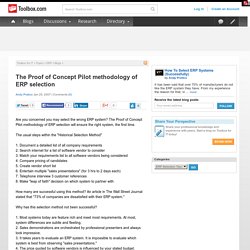
The Proof of Concept Pilot methodology of ERP selection will ensure the right system, the first time. The usual steps within the "Historical Selection Method" 1. Document a detailed list of all company requirements2. Search internet for a list of software vendor to consider3. How many are successful using this method? Why has this selection method not been successful? 1. An example of a successful proof of concept - ETL Solutions. In software development, a proof of concept can be a vital tool to demonstrate the software’s capabilities and its fit with the client’s requirements.

But how do you go about creating one? A recent example from our data integration work in the Oil & Gas industry illustrates the steps we take to create a successful proof of concept. You may also be interested in: How to create a successful proof of concept. Step 1: Defining the client’s requirements Our clients’ needs can range from testing the suitability of the proposed software to sharing knowledge within the client’s organisation.
In our example, there were two types of files - LAS and DLIS – to migrate in the context of the PPDM and WITSML industry standards. Embed transforms within near real-time message handling, particularly WITSMLData migration converting to LAS files to and from the client’s PPDM-based systemData migration converting to DLIS files to and from the client’s PPDM-based system. Step 2: Defining the client’s input. An example of a successful proof of concept - ETL Solutions. What is a Proof of Concept (POC)? - Definition from Techopedia. Proof of concept is a term with various interpretations in different areas.

POC in software development describes distinct processes with different objectives and participant roles. POC may also refer to partial solutions involving a small number of users acting in business roles to establish whether a system satisfies certain requirements. The overall objective of POC is to find solutions to technical problems, such as how systems can be integrated or throughput can be achieved through a given configuration. In the business world, POC is how startups demonstrate that a product is financially viable. POC involves extensive research and review and is submitted as a single package to concerned parties.
POC in digital arts and short films or animations requires making minimalist prototypes to determine whether a device works properly and is viable. Introduction to "Cloud Computing" Building Your Cloud Infrastructure: Converged Data Center without Dedicated Storage Nodes. Published: April 18, 2012 Updated: December 18, 2012.
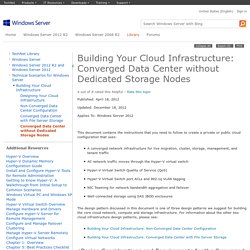
Building Your Cloud Infrastructure: Converged Data Center with File Server Storage. Published: February 29, 2012 Updated: September 19, 2012 Applies To: Windows Server 2012 This document contains the instructions to create a private or public cloud configuration that uses: Two subnets - one for cloud infrastructure traffic (live migration, cluster, storage and management) one for tenant traffic.
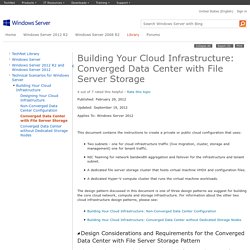
NIC Teaming for network bandwidth aggregation and failover for the infrastructure and tenant subnet. The design pattern discussed in this document is one of three design patterns we suggest for building the core cloud network, compute and storage infrastructure. The Converged Data Center with File Server Storage cloud infrastructure design pattern focuses on the following key requirements in the areas of networking, compute and storage: You require that cloud infrastructure traffic be physically separated from cloud tenant traffic. You require the ability to scale and manage storage separately from the compute infrastructure. Building Your Cloud Infrastructure: Non-Converged Data Center Configuration. Published: February 29, 2012 Updated: September 19, 2012 Applies To: Windows Server 2012 This document contains the instructions that you need to follow to create a private or public cloud configuration that uses: Separate network adapters for live migration, cluster, management, and tenant traffic Traditional SAN storage Optionally use Single Root I/O Virtualization (SR-IOV) The design pattern discussed in this document is one of three design patterns we suggest for building the core cloud compute and storage infrastructure.
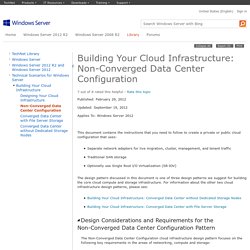
Designing Your Cloud Infrastructure. Many network architectures include a tiered design with three or more tiers such as core, distribution, and access.
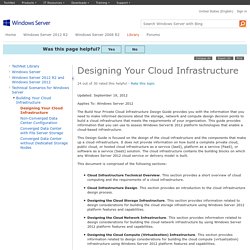
Designs are driven by the port bandwidth and quantity required at the edge, in addition to the ability of the distribution and core tiers to provide higher speed uplinks to aggregate traffic. Additional considerations include Ethernet broadcast boundaries and limitations, spanning tree or other loop-avoidance technologies. A dedicated management network is a frequent feature of advanced data center virtualization solutions.
Most virtualization vendors recommend that hosts be managed via a dedicated network so that there is no competition with tenant traffic and to provide a degree of separation for security and ease of management purposes. This historically implied dedicating a network adapter per host and port per network device to the management network. Managing the network environment in a private cloud can present challenges that must be addressed.